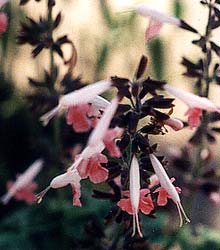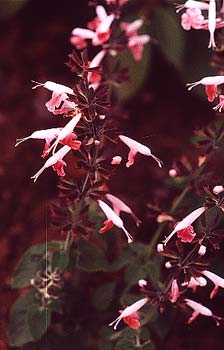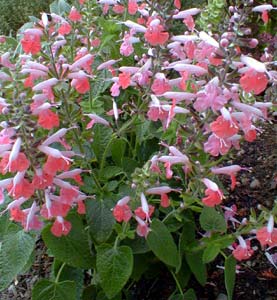
'Coral Nymph' Sage;
or, Hummingbird Sage
"How could such sweet and wholesome hours
Be reckoned but with herbs & flowers?"
-Andrew Marvel
(1621-1678)
(1621-1678)
Salvia coccinea is normally a scarlet-flowering subshrub called Scarlet Sage, Rosy Sage, or occasionally Blood Sage. It is not the same as the excessively tender South American S. splendins likewise called Scarlet Sage, which does not share S. coccinea's appeal to hummingbirds.
 Today S. coccinea has many differently colored cultivars, so that "Scarlet Sage" is a poor name for it, & the alternate "Hummingbird Sage" is the better name for the whole group of cultivars. In catalogs it is occasionally called Texas Scarlet Sage or Texas Hummingbird Sage, but "Texas Sage" would ordinarily refer to Leucophyllum frutescens.
Today S. coccinea has many differently colored cultivars, so that "Scarlet Sage" is a poor name for it, & the alternate "Hummingbird Sage" is the better name for the whole group of cultivars. In catalogs it is occasionally called Texas Scarlet Sage or Texas Hummingbird Sage, but "Texas Sage" would ordinarily refer to Leucophyllum frutescens.We planted a pink variety, 'Coral Nymph' aka 'Cherry Blossom.' Though sometimes represented as a dwarf, 'Coral Nymph' is a clumping perennial that can reach two feet tall, with heart-shaped or triangular pubescent leaves. The species is fragile here in Northwest, & Coral Nymph more so than other S. coccinea color varieties.
Outside its native range of the southwest & Central America, it often proves to be a self-seeding annual instead of a perennial, & will grow true from the seed. As an annual it can adapt in areas as cold as Zone 4, but Puget Sound weather, which is Zone 8, with very few winter days into the twenties, is right on the cusp of this sage's winter tolerances as a perennial.
At spring's end (in 2002), we planted two small specimens in a very sunny little-watered spot with the hope that it would behave as a perennial. One of these two specimens soon died to the ground. The other did excellently for the rest of the year.
 In June & much of July it was in full bloom, with flowers of salmon-coral & white, tubular in shape. The blooms stopped toward the end of July, but then late in August & especially in September it was in steady rebloom, & was still flowering in October! Having bushed out considerably through Summer & Fall, the second bloom was even more splendid since the plant had grown so much.
In June & much of July it was in full bloom, with flowers of salmon-coral & white, tubular in shape. The blooms stopped toward the end of July, but then late in August & especially in September it was in steady rebloom, & was still flowering in October! Having bushed out considerably through Summer & Fall, the second bloom was even more splendid since the plant had grown so much.It performed excellently for such a long period of flowering, but it had indeed been only an annual for us, & did not return for a second year. I kept watching for signs that it had self-seeded, but it had not. When S. coccinea manages to do so, it is one of those sorts of plants that can spring out of a tiny crack in a sidewalk or other unlikely location & do quite well.
In early summer 2003, we decided to plant it again, as the worst one cold say for it was it makes for a gorgeous defacto annual. The third photo shows the replacement clump in July. This time we're trying it on a humped up area in the roadside sun-garden, where come winter it would have archly maximum drainage, & it was protected on three sides by other sun-lovers. We also started with a larger plant this time, a gallon pot of it. It bloomed endlessly until late in autumn, but once again it did not return the following spring, nor did it self-seed. I'm even so not as yet disabused of my belief that I should be able to find the correctly protected yet sunny balance for it to achieve a perennial presence in our zone.
Coral Nymph is perhaps not the correct cultivar to be testing as a Puget Sound perennial, as it is known to be a mite more delicate than most of the varieties. Some of other choices to consider are 'Lady in Red,' 'Deep Apricot,' 'Snow Nymph' (or 'Alba'), & pale pink 'Brenthurst.'
These also make excellent container plants, & anyone not as focused as I am on perennials will find sufficient reward in the gorgeous summer & autumn flowers, even for cooler zones where they are strictly annuals.